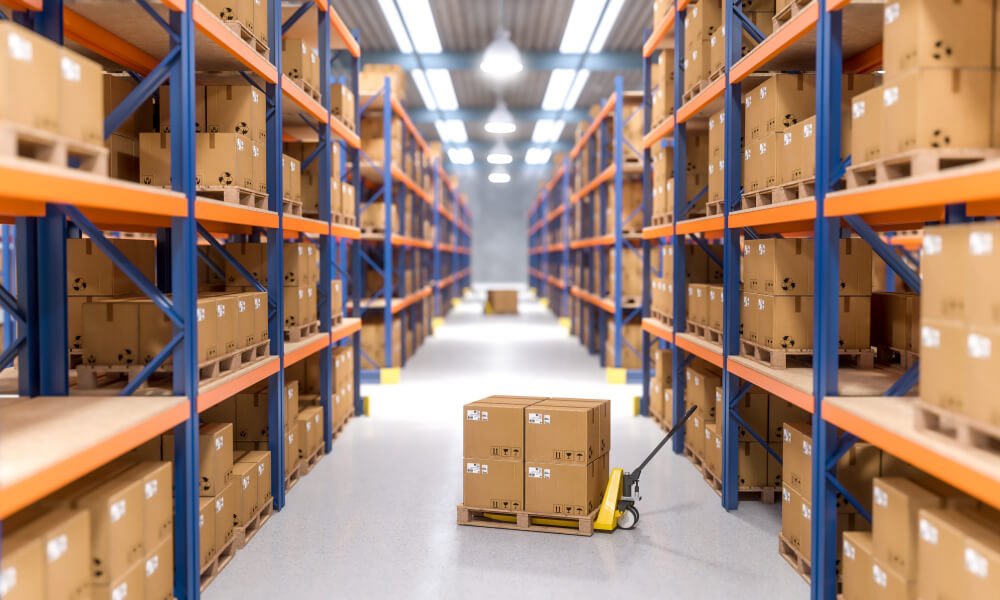Managing a warehouse efficiently is crucial for businesses to ensure smooth operations, reduce costs, and enhance customer satisfaction. The key to achieving this is optimising the warehouse management processes, including correct product flow in a warehouse.
So, what is the correct product flow in a warehouse? This blog guide will delve into the six primary warehouse processes and provide actionable tips to optimize each. From receiving and storage to picking, packing, shipping, and returns, we will explore the best practices to streamline your warehouse operations.
1. Receiving: Ensuring A Smooth Start

Optimizing this process is crucial to prevent delays and ensure the smooth flow of goods. To enhance the receiving process, consider implementing the following strategies:
- Automated Verification: Utilize advanced systems, such as barcode scanners and RFID technology, to automate the verification process and minimize errors.
- Dock Optimization: Implement efficient dock scheduling and labour management systems to allocate the right number of personnel and prevent overcrowding at receiving docks.
- Dimensioning Systems: Invest in parcel and pallet dimensioning systems to automate the capture of weight and dimensions, ensuring accurate measurements and faster processing.
- Utilize Machinery: Use the help of power pallet trucks and conveyor belts to smooth the unloading operation. It will also help to clear the dock areas in no time.
- Damage Identification: Train receiving personnel to promptly identify and document any damaged goods, allowing for timely claims and minimizing liability.
2. Storage: Maximizing Space
Efficient storage is essential for maximizing space utilization and labor efficiency within a warehouse.
Optimizing the storage process involves strategically placing goods in the most suitable locations. Here are some strategies to optimize your storage process:
- KPI Tracking: Implement software systems that track key performance indicators (KPIs) to evaluate your storage process’s efficiency and identify improvement areas.
- Slotting Optimization: Utilize slotting and space management software to assign optimal storage spaces for each product, reducing travel time and improving overall efficiency.
- Warehouse Storage Systems: Choose the right storage system based on the size of your facility and product mix. This ensures efficient utilization of horizontal and vertical spaces.
- Inventory Management: Implement real-time inventory management systems to track stock levels accurately and facilitate efficient storage and retrieval.
3. Picking: Enhancing Accuracy And Efficiency
Picking is a critical and costliest warehouse process that involves selecting products from inventory to fulfill customer orders. Almost 55% of the total operating expense is used in this process. So, optimizing the picking process is crucial for reducing costs and enhancing order accuracy.
Consider the following strategies to optimize your picking process:
- Order Consolidation: Group orders by proximity to minimize travel time and enable efficient batch picking.
- Technology Integration: Equip pickers with mobile devices and wearable technology to access real-time picking lists, scan products, and navigate the warehouse efficiently.
- ABC Analysis: Conduct an ABC analysis to categorize products based on demand and optimize their placement within the warehouse layout.
- Picking Methodology: Choose the most suitable picking methodology, such as batch picking, zone picking, or wave picking, based on your warehouse’s specific requirements.
4. Packing: Ensuring Safe And Efficient Shipment
The packing process involves consolidating picked items into packages for shipment. Optimizing the packing process is necessary to ensure product integrity, minimise packaging costs, and expedite shipping. This process also involves selecting the right material for packing e.g glass or ceramic items require cushions packing to avoid any damage.
Consider the following strategies to optimize your packing process:
- Automated Packaging Systems: Implement automated packaging systems that determine the appropriate packaging material based on item dimensions and weight, reducing errors and costs.
- Standardized Packing Procedures: Develop standardized packing procedures to ensure consistency and minimize the time spent packing each order.
- Quality Control Checks: Implement quality control checks to verify the accuracy and condition of packed items before shipping.
- Packing Stations: Set up dedicated packing stations with all necessary materials, tools, and technology to streamline the packing process.
5. Shipping: Efficiently Delivering Orders
Shipment is the step in the warehouse management process where orders are dispatched to customers. You can label this process as the start of the voyage for a product.
Optimizing the shipping process is crucial for timely and accurate order fulfilment. It will only be considered a successful shipment if the correct order is dispatched to its rightful location, travels through the correct transit mode, and is delivered safely and on time.
Consider the following strategies to optimize your shipping process:
- Workforce Management Systems: Utilize workforce management systems to allocate the right resources and prevent over or under-allocation of personnel.
- Real-Time Information: Equip shipping personnel with mobile applications to access real-time shipment information, verify deliveries, and address any issues promptly.
- Loading Systems: Implement loading systems that provide clear instructions on loading cargo safely and efficiently, minimizing the risk of damage during transit.
- Carrier Selection: Evaluate carrier performance and select reliable shipping partners to ensure on-time delivery and customer satisfaction.
6. Returns: Efficiently Handling Product Returns
Handling product returns is an inevitable part of the warehouse management process. Sometimes, customers who are unsatisfied with the end product initiate a return request. Thus, optimizing the returns process is vital for minimizing costs and ensuring customer satisfaction.
Consider the following strategies to optimize your returns process:
- Dedicated Returns Area: Designate a specific area within the warehouse for processing returns, ensuring efficient handling and organization of returned items.
- Three-Bin System: Implementing a three-bin system for returned items, categorizing them as discard, restock, or return to the supplier, streamlines the decision-making process.
- Return Policy: Establish a clear and customer-friendly return policy to minimize the number of returns and facilitate the return process for customers.
- Damage Assessment: Train warehouse personnel to inspect returned items thoroughly, document any damages, and initiate appropriate actions.
Conclusion
By optimizing these six primary warehouse management processes, you can significantly enhance your warehouse’s efficiency, reduce costs, and improve customer satisfaction. Implementing advanced technologies, streamlining workflows, and continuously evaluating and improving your processes will help you stay ahead in the competitive warehousing world.
Remember, effective warehouse management is an ongoing process that requires continuous monitoring, adaptation, and improvement. Stay proactive and embrace new technologies to optimize your warehouse processes for maximum success.







